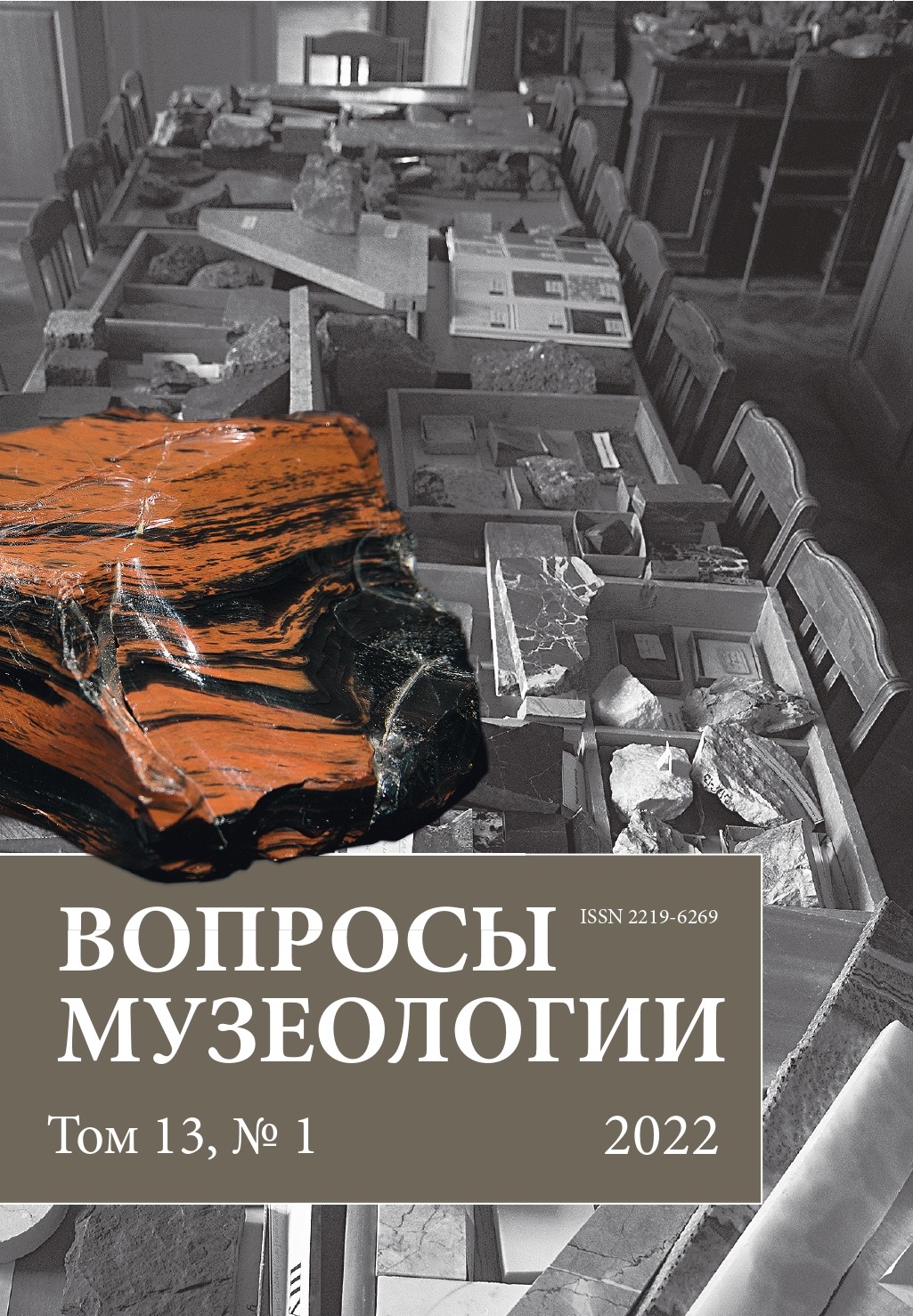Experience of studying ornaments on kiselnitsa from the collection of the Nizhny Novgorod State Reserve Museum of History and Architecture
DOI:
https://doi.org/10.21638/spbu27.2022.107Abstract
The article presents the experience of studying one of the types of peasant pottery — kiselnitsa. In the collection of Nizhny Novgorod Museum-Reserve there are kiselnitsy of the 19th — early 20th centuries with relief ornaments that were imprinted on the kissel. This ritual dish was served in the Nizhny Novgorod Region at commemorations and weddings, so the kiselnitsa’s ornament is of particular importance. Researchers from different fields study ornament as an anthropological and cultural-historical phenomenon and come to the conclusion that it can indicate both the belonging of an object to a certain ritual and demonstrate a universal sign system adopted in a particular society. This is especially true for ethnographic objects. Numerous works on ornaments on traditional Russian embroidery and wood carving have already been written, but clay is little explored in this regard. However, kiselnitsy provide ample opportunities, since the ornaments on them are very diverse: geometric, vegetable, zoomorphic. The author examined eight objects with different ornamentation, divided the ornaments into types, and through universal signs characteristic of Slavic paganism as well as displayed in other types of Russian crafts, tried to reveal the meaning of the ornament and its belonging to a particular ritual. Only such an in-depth study of the object will allow us to better understand its cultural and historical significance and thereby expand its exposition possibilities in the museum. Communication with the object will be built in a new way: kiselnitsy can broadcast information not only about life, crafts and aesthetics of our ancestors, but about their ideas about the world and the rituals, traces of which are found in modern society.
Keywords:
clay dishes, kiselnitsa, ornament, Nizhny Novgorod Museum-Reserve
Downloads
References
Богуславская И.Я. (ред.). 1981. Добрых рук мастерство: произведения народного искусства в собрании Государственного Русского музея. Л.: Искусство.
Гусарова Т., Шмелев Е. 2019. Гончарные промыслы Нижегородчины. URL: http://opentextnn.ru/museum/ethnological-museum/promysly-i-remesla/gusarova-t-shmelev-e-goncharnye-promyslynizhegorodchiny (дата обращения: 09.02.2022)
Левыкин К.Г., Хербст В. (ред.). 1988. Музееведение. Музеи исторического профиля: учебное пособие для вузов по специальности «История». М.: Высшая школа.
Маслова Г.С. 1978. Орнамент русской народной вышивки как историко-этнографический источник. М.: Наука.
Морохин В.Н. (сост.). 1971. Нижегородские предания и легенды. Горький: Волго-Вятское кн. изд-во.
Петрова Л.Л. 2005. Народное искусство Белозерья: путеводитель. М.: Северный паломник.
Попова О.С. 1972. Русское народное искусство. М.: Легкая индустрия.
Привалова В.М. 2010. Семантика орнамента в семиотике культуры (антропологическая проекция ритуала в геометрическом орнаменте). Известия Самарского научного центра Российской академии наук 12 (5): 277–283.
Рыбаков Б.А. 2016. Язычество Древней Руси. М.: Академический проект.
Сафонова Г.Б. 2009. Традиционная обрядовая керамика Верхней Оки. Верхнее Подонье: Археология. История. Сб. науч. ст. Тула: Гос. воен.-ист. и природ. музей-заповедник «Куликово поле». С. 130–140.
Терещенко А. 1848. Быт русского народа. Ч. 3. СПб.: Типография военно-учебных заведений.
Токсубаева Л.С. 2014. Русское народное искусство Казанского Поволжья XIX–ХХ веков: деревянная домовая резьба, вышивка, бранное ткачество, кружево. Казань: Центр инновационных технологий.
Толстой Н.И. (ред.) 1995. Славянские древности: этнолингвистический словарь в 5 томах. Т. 1. М.: Международные отношения.
Толстой Н.И. (ред.) 1999. Славянские древности: этнолингвистический словарь в 5 томах. Т. 2. М.: Международные отношения.
Толстой Н.И. (ред.) 2009. Славянские древности: этнолингвистический словарь в 5 томах. Т. 4. М.: Международные отношения.
Трусова М.П. 2016. Глиняные кисельницы села Богородского конца XIX — начала XX века в собрании Нижегородского государственного историко-архитектурного музея-заповедника. Вопросы музеологии 2 (14): 100–107.
Boguslavskaia I.Ia. (ed.). 1981. Craftsmanship: works of folk art in the collection of the State Russian Museum. Leningrad: Iskusstvo Publ. (In Russian)
Gusarova T., Shmelev E. Pottery crafts of Nizhny Novgorod. URL: http://opentextnn.ru/museum/ethnological-museum/promysly-i-remesla/gusarova-t-shmelev-e-goncharnye-promysly-nizhegorodchiny (accessed: 09.02.2022). (In Russian)
Levykin K.G., Kherbst V. (ed.). 1988. Museology. Museums of historical profile: an educational aid for “History” specialty universities. Moscow: Vysshaia shkola Publ. (In Russian)
Maslova G. S. 1978. The ornament of Russian folk embroidery as a historical and ethnographic source. Moscow: Nauka Publ. (In Russian)
Morokhin V.N. (ed.). 1971. Nizhny Novgorod tales and legends. Gorky: Volgo-Viatskoe knizhnoe izdatel’stvo Publ. (In Russian)
Petrova L.L. 2005. Folk art of Belozerye: a guide. Moscow: Severnyi palomnik Publ. (In Russian)
Popova O. S. 1972. Russian folk art. Moscow: Legkaia industriia Publ. (In Russian)
Privalova V.M. 2010. Semantics of ornament in the semiotics of culture (anthropological projection of ritual in geometric ornament). Izvestiia Samarskogo nauchnogo tsentra Rossiiskoi akademii nauk 12 (5): 277–283. (In Russian)
Rybakov B.A. 2016. Paganism of Ancient Russia. Moscow: Akademicheskii proekt Publ. (In Russian)
Safonova G.B. 2009. Traditional ceremonial ceramics of the Upper Oka. Upper Don: Archeology. History. Sbornik nauchnykh statei Tula: Gosudarstvennyi voenno-istoricheskii i prirodnyi muzei-zapovednik “Kulikovo pole”. P. 130–140. (In Russian)
Tereshchenko A. 1848. Household life of Russian folk. Ch. 3. St Petersburg: Tipografiia voenno-uchebnykh zavedenii. (In Russian)
Toksubaeva L. S. 2014. Russian folk art of the Kazan Volga region of the XIX–XX centuries: wooden house carving, embroidery, textile weaving, lace. Kazan: Tsentr innovatsionnykh tekhnologii Publ. (In Russian)
Tolstoi N.I. (ed.). 1995. Slavic Antiquities: an ethnolinguistic dictionary in 5 vols. Vol. 1. Moscow: Mezhdunarodnye otnosheniia Publ. (In Russian)
Tolstoi N.I. (ed.). 1999. Slavic Antiquities: an ethnolinguistic dictionary in 5 vols. Vol. 2. Moscow: Mezhdunarodnye otnosheniia Publ. (In Russian)
Tolstoi N.I. (ed.). 2009. Slavic Antiquities: an ethnolinguistic dictionary in 5 vols. Vol. 4. Moscow: Mezhdunarodnye otnosheniia Publ. (In Russian)
Trusova M.P. 2016. Clay kiselniy of the Bogorodskoe village of the late 19th and early 20th century in the collection of the Nizhny Novgorod State History and Architecture Museum-Reserve. Voprosy muzeologii 2 (14): 100–107. (In Russian)
Downloads
Published
How to Cite
Issue
Section
License
Articles of "The Issues of Museology" are open access distributed under the terms of the License Agreement with Saint Petersburg State University, which permits to the authors unrestricted distribution and self-archiving free of charge.




